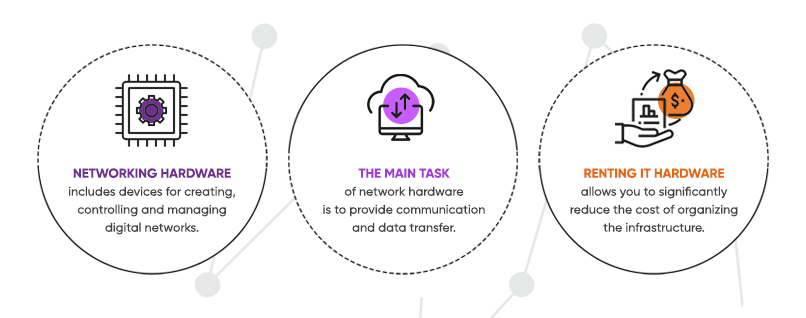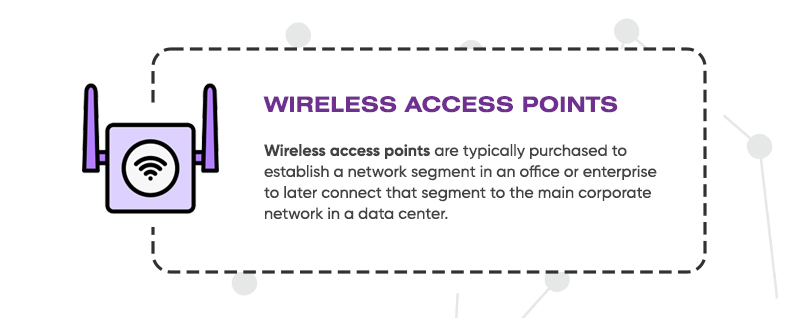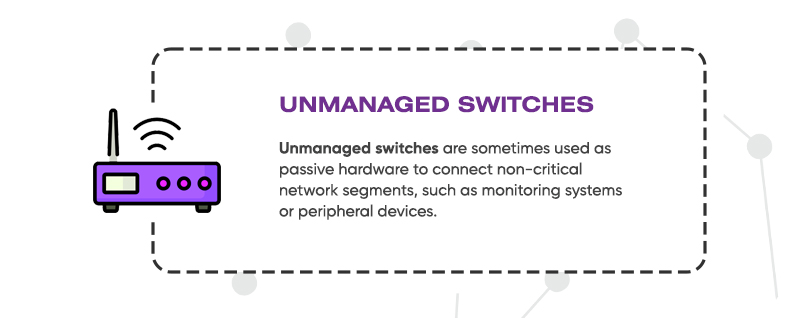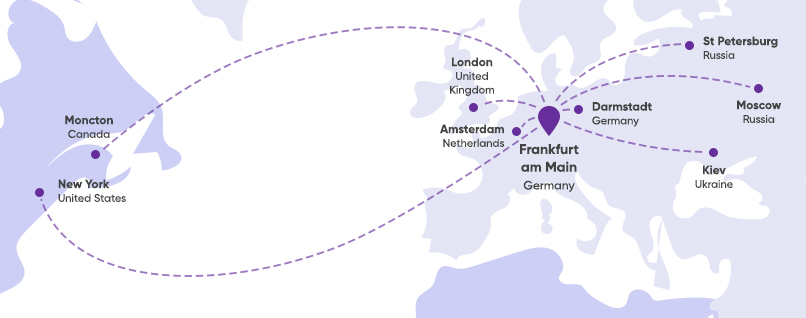Networking hardware is generally understood as devices for creating, controlling and managing digital networks. The main task of network hardware is to provide communication and data transfer.
 When creating corporate networks, expensive network devices are often used. It is not always profitable to purchase them, especially if there is a need to promptly launch a new network segment or to replace failed hardware for a certain period of time. In this case, renting IT hardware is the best option, as it allows you to significantly reduce the cost of organizing the infrastructure.
When creating corporate networks, expensive network devices are often used. It is not always profitable to purchase them, especially if there is a need to promptly launch a new network segment or to replace failed hardware for a certain period of time. In this case, renting IT hardware is the best option, as it allows you to significantly reduce the cost of organizing the infrastructure.
Almost all major cloud hosting providers in Europe can offer network devices for rent. The choice of hardware always depends directly on the architecture, purpose and technical requirements of the network. Creating comprehensive network structures requires a lot of experience, high qualification, understanding of modern trends and design approaches. Some IT hardware rental companies offer free consulting services as a bonus, which is another argument in favor of network hardware rental.
What network hardware can be rented
By purpose, network hardware is traditionally divided into active and passive.
Active: devices capable of amplifying, converting and transmitting the received signal. They include:
- Firewalls
- Switches
- Routers
- Wireless Access Points
Wireless access points are typically purchased to establish a network segment in an office or enterprise to later connect that segment to the main corporate network in a data center.

Passive hardware is not designed to amplify the received signal and is always a complement to the active hardware.
Passive hardware includes the following:
- Media converters
- Transceivers
- Unmanaged switches
Unmanaged switches are sometimes used as passive hardware to connect non-critical network segments, such as monitoring systems or peripheral devices.

The price of passive hardware is rarely high, so it is usually not a rental item. The most popular on the market is active hardware: firewalls, switches and routers. A little more about them below.
Firewalls
Firewall: a hardware and software system whose main function is to monitor and filter network signals. Firewalls are security devices. They are also called inter-network screens, because firewalls control traffic passing between different networks and network zones. Such hardware helps to protect the network from DDoS attacks, can stop traffic spoofing, and block data transmission to an unknown IP address.
The selection of firewall hardware solution directly depends on the specifics of the infrastructure and the functional requirements of the device. A firewall can be universal or highly specialized. There are hybrid solutions that require high engineering skills from the personnel maintaining the network.
Important criteria for selecting a firewall:
- bandwidth of internal and external ports;
- number of simultaneously supported VPN sessions;
- availability of online updates from the main repository of the hardware manufacturer.
Switches
Switches are used to connect all connected devices within a single local area network (LAN). Switches can detect MAC addresses and send data only to the devices for which the signal was intended. Such hardware helps to improve network performance and security.
Switches are categorized as managed and unmanaged based on their functionality.
- Unmanaged: have a relatively low cost and transmit the signal efficiently only when there are no heavy loads. Under heavy loads, they are not capable of maintaining high data rates. In addition, they cannot be configured, which reduces network security.
- Managed: enhanced with SNMP and VLAN support. SNMP protocol allows you to manage the switch remotely and receive certain data from it. This is usually necessary for monitoring and statistics collection. The VLAN option allows you to combine several devices into one network regardless of their physical location. Leading manufacturers of network hardware are constantly improving the software, and the functionality of each specific device depends on the purpose and can be very different. The advantages of managed switches are most relevant when designing large networks with simultaneous connection of a large number of devices.
When there is a need to increase bandwidth and provide a fail-safe, secure solution, stackable switches are often used. Stacking technology allows synchronizing the operation of multiple switches so that they appear as a single device to the receiving server.
By linking multiple switches together, link aggregation is possible, which increases network capacity. Management is simplified because stackable switches share a single interface. Another advantage is increased fault tolerance: failure of one device does not critically affect the network connectivity. Stackable switches are used, for example, to implement Colocation service.
Name of stacking technology from different manufacturers
| Name of stacking technology |
| Stack |
| Virtual Chassis |
| Logical Chassis |
| iStack |
| IRF |
Routers
Routers enable the transmission of data between different networks. They receive data packets and determine which path to take to send the signal to its destination. Routers use routing tables at the software level to determine the optimal path for data transmission. In other words, routers are a more advanced version of switches.
Managed switches are often more expensive than conventional routers due to the functionality that allows the user to select the assignment and prioritization of different ports. In addition, managed switches can serve multiple virtual networks at once, which allows isolating devices from different network segments.
![]()
![]()
Some IT hardware rental companies offer their customers high-speed Cloud Core Routers. This is a hardware that uses the cloud computing principle as an alternative to the classic method. In traditional routers, all the data and settings are physically stored on the device itself. Modern cloud router software from leading vendors can be run on a remote server. That is, cloud routers can leverage the performance of remote servers to compute routing operations. Modern cloud router software from leading vendors can be run on a remote server. That is, cloud routers can leverage the performance of remote servers to compute routing operations.
On one hand, this allows you to increase productivity to almost any level; on the other hand, this method is not yet common. Most service providers prefer to work with traditional routers simply because such hardware is more predictable and reliable
Advantages of leasing network hardware: how to save up to 30% and other benefits
Network hardware rental is a good way to save money on network infrastructure organization. The customer can solve most maintenance issues directly through the service provider and thus enjoy a number of advantages:
- The rental hardware is maintained by the provider. If something breaks, the owner will replace components or the entire equipment free of charge. Usually, the agreement stipulates not only the terms of emergency replacement, but also the provider’s obligations to ensure information security and the level of fault tolerance of the hardware.
- Quick start and flexible scalability. The devices that the provider offers for rent do not need to be ordered from the manufacturer, they are already in stock. Connection and configuration are carried out in the shortest possible time, which allows you not only to quickly start work, but also to quickly ensure performance growth in the future by connecting new hardware, if necessary.
- The provider deals with licensing issues itself. The client does not need to renew license agreements and pay a separate vendor for both hardware and software. Network hardware receives updates and firmware directly from the manufacturer.
- Some companies offer post-warranty service. After the end of the warranty period from the manufacturer, replacement of any failed components will be free of charge if the client pays a monthly subscription fee.
- Network devices can be leased under a leasing model with an option to buy them out later. Such financing of IT hardware has several advantages. Firstly, leasing payments can be formalized as company expenses, which will save 15 to 30% on VAT. Secondly, under the leasing contract the client pays only 2-3% of the cost at the first payment. For example, if the total cost of all technical equipment is €10,000, the first payment will be only €200!
When you need to rent network hardware
Most often network hardware is rented when it is necessary to urgently organize network infrastructure or a temporary solution with minimal costs, and in both cases it is possible to reduce the risks and costs of financing IT-infrastructure by leasing. First of all, this is relevant when it is necessary to launch a large-scale infrastructure that requires dozens or even hundreds of network devices.
Creating a corporate virtual network: a case study of a company from Germany
Thanks to virtualization technologies, network hardware allows you to combine local networks that are physically located in different regions so that the system sees them as one common virtual network. This scheme is called Site-to-Site VPN.
For example, a company whose main infrastructure and data center are located in Germany opens a representative office in another country with offices in different cities. A server room, to which all regional offices are connected, is set up in the territory of another country. Then, using network hardware and virtualization technologies, the new local network is connected to the main corporate network located in Germany. It is always possible to segment the virtual network, configure access levels and data exchange mechanisms. The authorization system for corporate accounts can be unified, including the use of smart cards and biometric data. Encryption technologies used in Site-to-Site VPN are very reliable and almost exclude interception and decryption of data transmitted between network segments.
 Urgent organization of network infrastructure with the use of Site-to-Site VPN technology may be necessary when opening representative offices in new countries, when buying other companies, during mergers and acquisitions.
Urgent organization of network infrastructure with the use of Site-to-Site VPN technology may be necessary when opening representative offices in new countries, when buying other companies, during mergers and acquisitions.
Organization of an isolated and secure communication channel for corporate traffic
In some cases, companies and enterprises need to organize a high-speed isolated traffic channel between locations that are geographically located in different countries. This service is especially relevant when traditional methods of traffic exchange are complicated by economic, legal or political restrictions. In this case, renting high-speed network hardware helps to create a stable and secure communication channel that can be used on a temporary or permanent basis.
Network hardware rental: streamlining virtual networks for businesses and reducing costs of IT infrastructure
Write us a message to get additional information.
or book a free consultation
We’ve studied network hardware rental rates from 20 major European providers especially for you. If you would like to get this information, organize your own corporate network project or purchase hardware, book a free consultation with a network and cloud specialist. We can help you calculate estimates and implementation costs, and tell you about the possibilities of leasing network hardware under a leasing agreement. You can book a conversation here.
Article author Olga Boujanova dedicated server expert and a business development consultant
